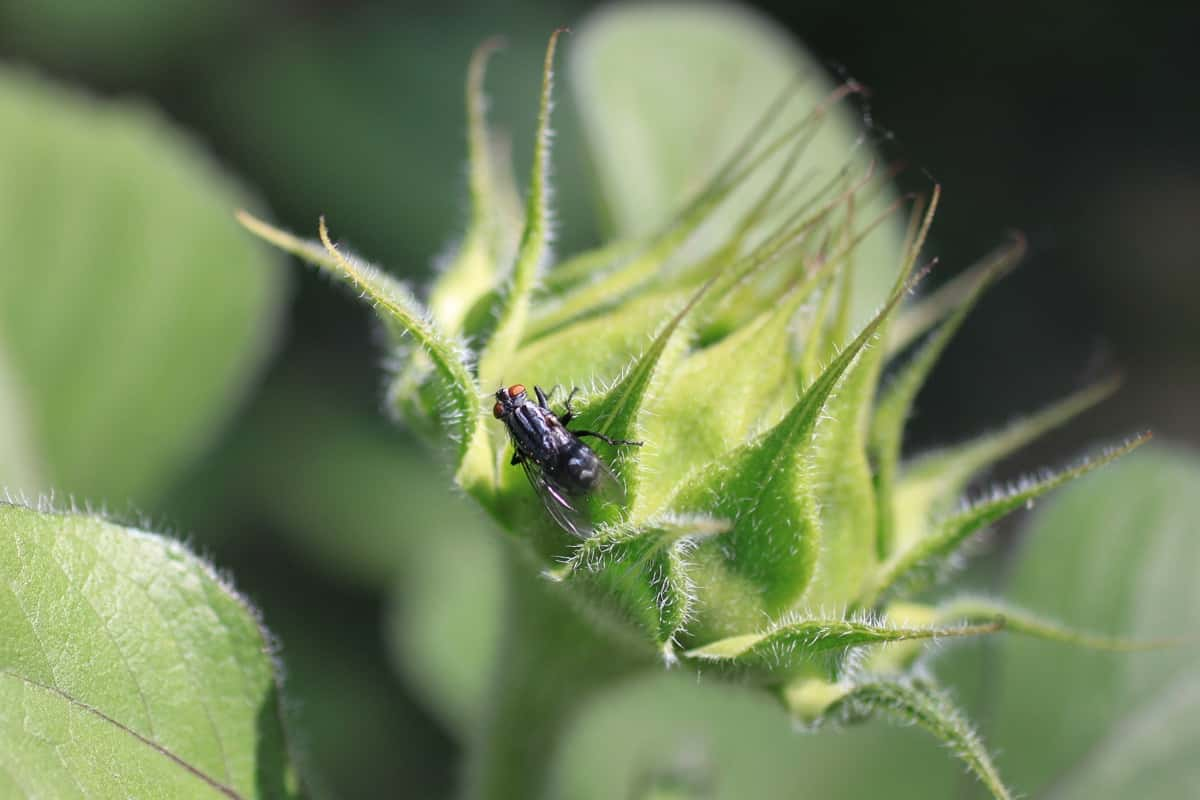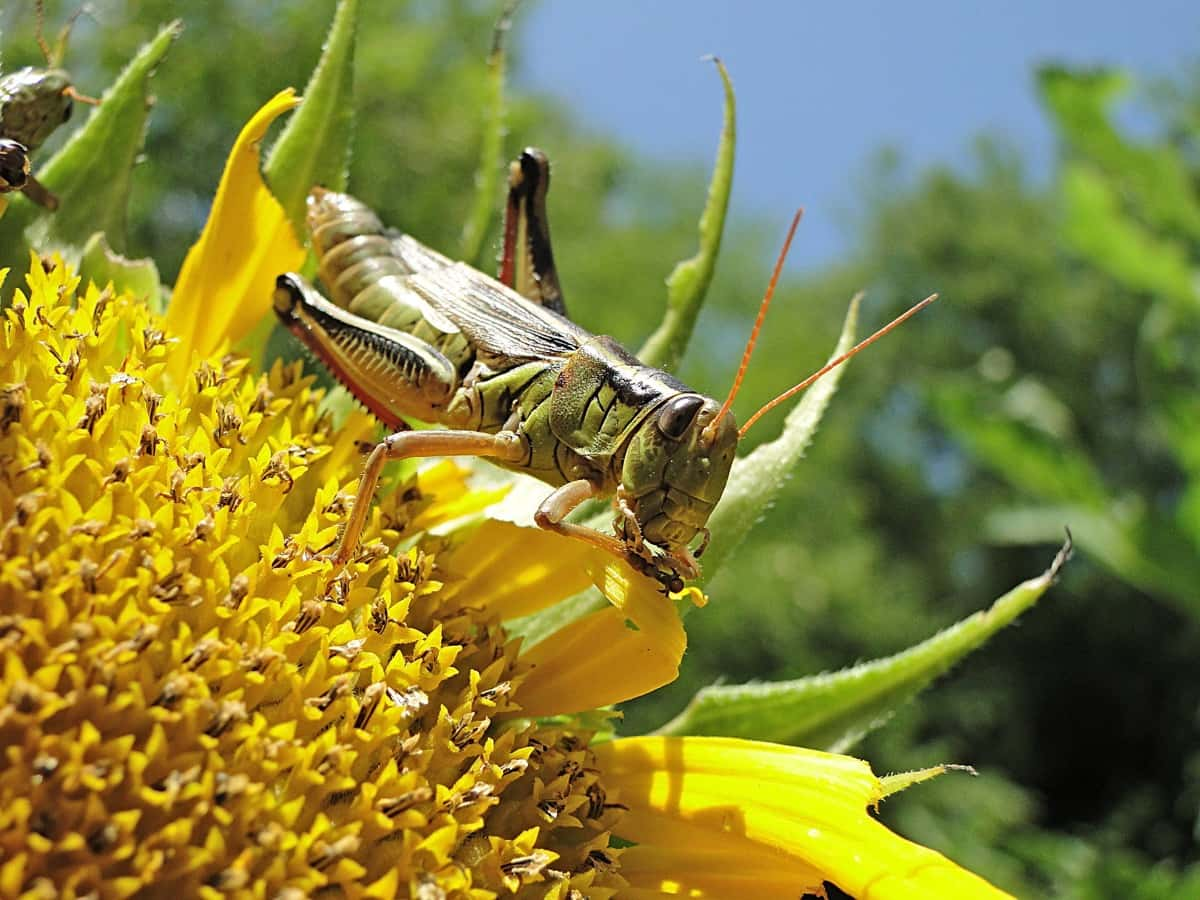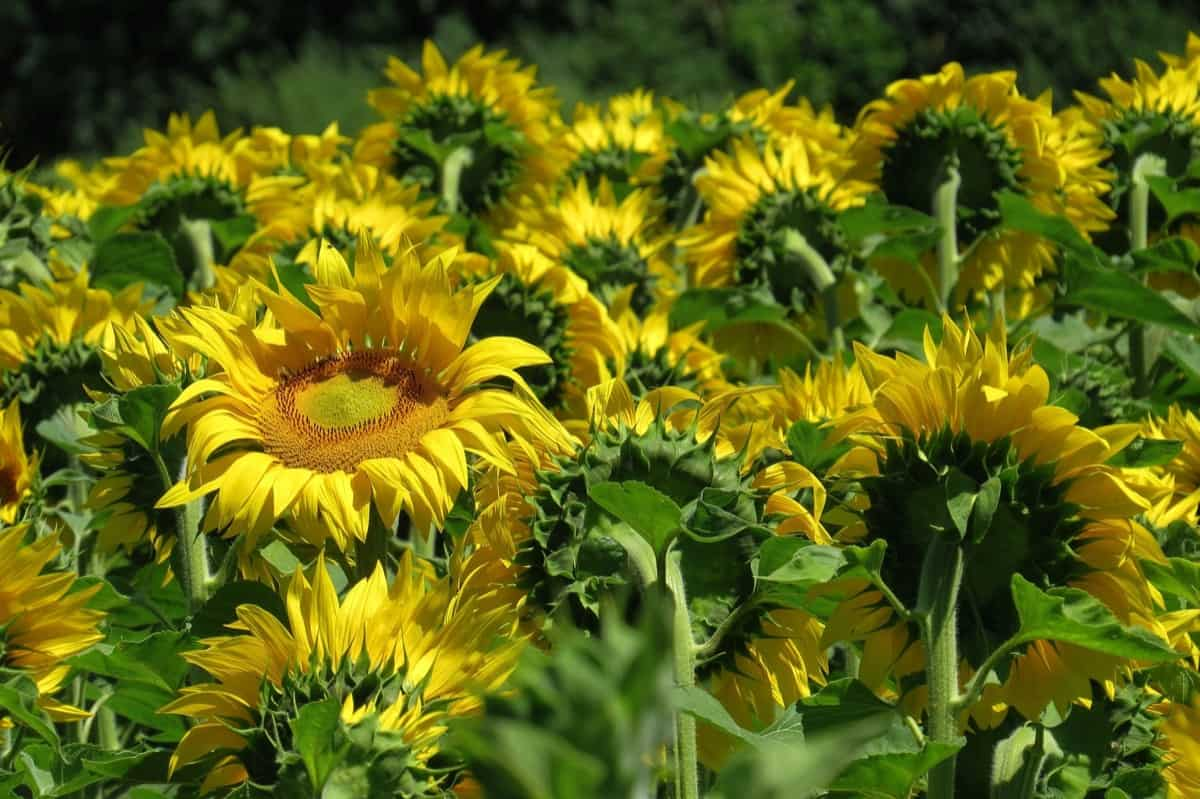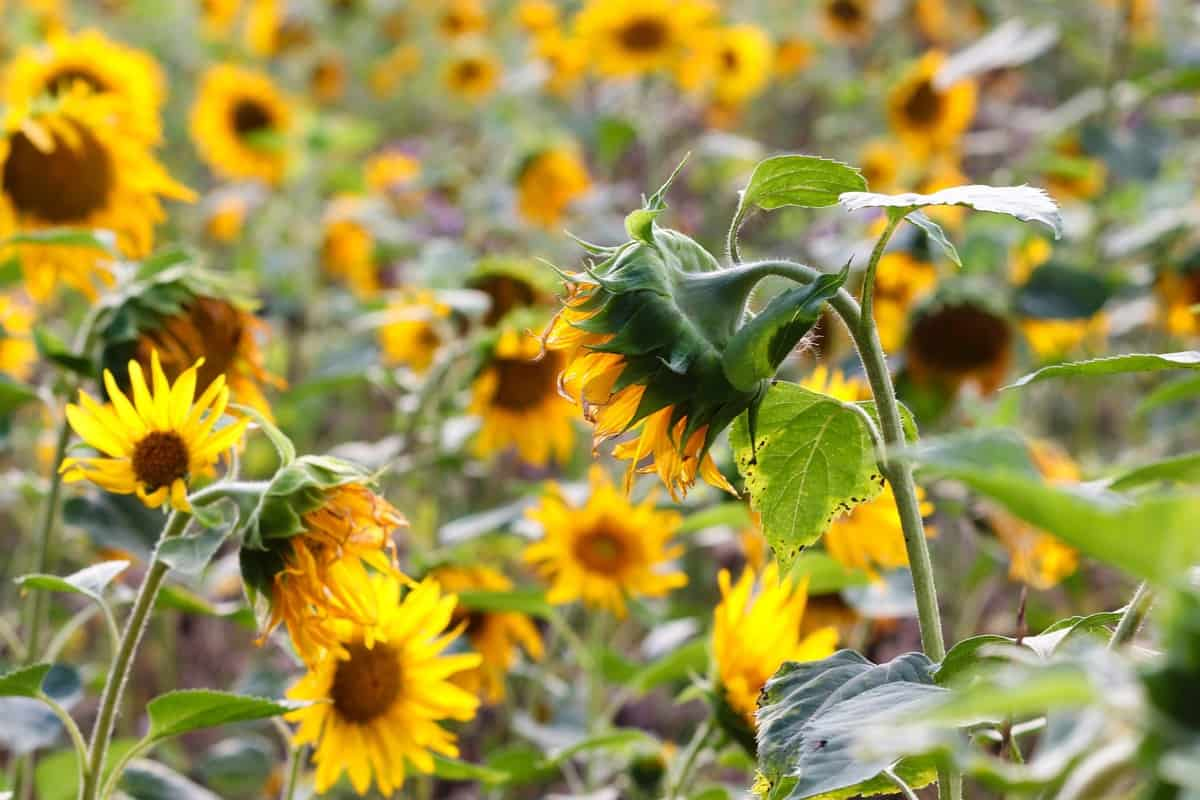Sunflowers are annual herbaceous plants in the Asteraceae family known for their seeds. Plants with thick, hairy, erect stems produce large flower heads. Lower leaves are large, broad, and arranged alternately on the stem, while upper leaves are smaller, narrower, and attached individually to the stem. Approximately 10-30 cm in diameter, the flower head comprises 16- 30 yellow-gold florets. In the central disc of the flower head, the inner florets will mature into seeds while the outer florets are sterile.

Sunflowers are annual plants that mature after one growing season and can reach a height of 1–3.5 m. In North America, sunflowers are also known as Girasole. At least 30 diseases caused by various fungi, bacteria, and viruses have been identified in wild or cultivated sunflowers, but only a few are of economic significance in causing yield losses. This article identifies many of the diseases affecting sunflower crops and provides information about the disease, its impact, and control measures, along with major pests as well.
Pest and disease management in Sunflower
Major pests in sunflower crops
Thrips
A thrip is a tiny insect about the size of a sewing needle and feeds on many plants worldwide. The thrip, also known as a thunder fly or Thysanoptera, is a sucking insect that can wreak havoc on plants. The damage they cause to plants can, however, be exacerbated when they transmit viruses to the plants.
Identification
Adult thrips are slender and very small insects at 1 / 50 to 1 / 25 inches long. The colors of these creatures can range from yellow to brown or black; if you try to get close to them, they are very likely to leap or fly away from you. The wings of these insects are narrow and fringed. Although the nymphs are smaller than the adults, their colors tend to be lighter, like light green and yellow, rather than the darker colors of the adults. In addition, their wings are not fully developed, and sometimes their eyes are red. On your plants, thrips appear as tiny dark slivers.
Damage symptoms
- Adults and nymphs consume leaves by rasping their surface tissues and sucking their exuded juices.
- There is usually little damage to seedlings; however, when the thrips population is high, the cotyledons and leaves are distorted and brown.
- Seedlings can become stunted and die due to these conditions.
- Thrips transmit the tobacco streak virus.
Biological control
- Release commercially available beneficial insects, such as minute pirate bugs, which feed on eggs and larvae before they become adults.
- Moreover, ladybugs and lacewings are particularly effective in destroying all stages of this pest in greenhouses.
- Make releases after knocking down severe infestations with water spray or another method for best results.
In case you missed it: Best Fertilizer for Sunflower Crop: Organic, NPK, Compost Manure, and Schedule

Chemical control
- Spraying sunflowers with a narrow-range oil, neem oil, or insecticidal soap thoroughly kills aphids but have no lasting effect, allowing beneficial insects to return and control aphids.
- Sometimes it is necessary to repeat the application process. Applying soap or oil to drought-stressed plants or when the temperature exceeds 33°C can injure the sunflowers.
- Alternatively, Spray any one of the following in the nursery stage and main field stage :
- Phosphamidon 40 SL 50 ml (or) Monocrotophos 36 SL 40 ml
2. Cutworm
Most often, cutworms feed on sunflowers right after they emerge. Most species hatch their eggs in May or June after laying them the previous summer. Cutworms can damage young plants because they feed on foliage and cut through the stems. Cutworms are more likely to cause damage when soils are cooler and moist. It inhibits sunflower development and contributes to plant stand reduction. Most cutworm feeding activity occurs at night, usually remaining dormant during the day.
Identification
Cutworms may be pink, green, brown, or black, varying in color depending on the species. Their bodies tend to be striped lengthwise, usually in a muted color. A common black cutworm attacks sunflowers and vegetable gardens when disturbed. These creatures curl up into a “C” after being disturbed. As larvae, they are plump, grayish-brown, and greasy looking, growing up to 2 inches in length.
Damage symptoms
Sunflower seedlings are most severely damaged by the insect’s larvae, which can cut off the young plants’ neck stems, causing them to die. When the stem becomes thick and strong, mature larvae cannot eat it, so they only invade young plants with tender shoots.
- Young seedlings can be collapsed when cutworm larvae sever stems at ground level.
- Some young plants are partially dragged into the soil, where larvae feed.
- Additionally, larvae can climb plants and eat leaves.
- As cutworms attack crops patchily, they may migrate to adjacent fields after destroying seedlings in one area
- There is one generation of risk per crop during the summer and spring.
Biological control
Earwigs, orange caterpillar parasites, two-toned caterpillar parasites, orchid dupes, spiders, and Bt attack cutworms.
Chemical and control management
- A weekly inspection of budding plants and emerging seedlings is necessary.
- Apply insecticides like Carbaryl, chlorpyrifos, etc. Do not apply chlorpyrifos again within ten days of the first application. Do not graze or feed treated forage.
- The seedlings should be treated if there is a rapid increase in the area or proportion of crop damage exceeding 10%.
- Treat older plants if more than 90% are infested, or more than 50% have 75% or more leaf tissue loss.
Sunflower Beetles
Typically found in northern growing regions, the sunflower beetle feeds on sunflower foliage. If sunflower beetles attack young plants, they can cause significant yield losses. Often misidentified as Colorado potato beetles, sunflower beetles measure 14 to 12 inches in length with black longitudinal stripes on a white thorax. Sunflower beetles produce only one generation per year and feed for six weeks. With long, hot weather periods, eggs can dry out, and heavy rains can displace larvae from their host plants.
In case you missed it: Organic Sunflower Production – Cultivation, Farming

Identification
Reddish-brown longitudinal stripes cover the wings of these round beetles with a red-brown head. The larvae are almost cute, with their pale green to yellow bowling pin shapes. Shotholes are created in leaves by adult feeding, and larvae eat transparent windows. The sunflower beetle is specific to Helianthus. In North America, they are the most damaging defoliator of sunflowers.
Damage symptoms
- Defoliation and enlarged seeds that lack a kernel
- Empty kernels, as they can completely consume seeds
- Reduced seed weight and oil content
- There is a possibility of partially empty kernels since they can consume about 13% of the kernel’s size
- The weight and oil content of seeds have been reduced
- Smaller holes on leaf surfaces caused by mature sunflower beetles
- Larvae feeding on foliage create large windows
Biological control
- Beneficial insects in nature usually control beetle numbers. A variety of ladybugs, including thirteen-spotted and convergent varieties, eat eggs.
- Damsel bugs, two-spotted stink bugs, and ground beetles also eat larvae.
Chemical control
- Apply Carbaryl at 450 to 700 grams ai/Acre. Do not apply within 30 days of grazing or harvest for forage.
- Apply Chlorantraniliprole at 150 to 250 ml/Acre. Do not apply more than 55 grams ai/Acre per season of lambda-cyhalothrin or more than 90 grams ai/Acre of chlorantraniliprole.
Sunflower Moths
Pests that damage sunflowers the most are sunflower moths. There are two generations each year, and most of the damage to sunflowers is caused by its larvae, which spend the winter in the soil. During the larval stage, the pollen is eaten, or the floral organs are attacked. In the injuries caused by this pest, other pathogens can grow. Silk threads and feces cover the affected organs.
Identification
An adult sunflower moth measures 3/4 inches long, is shiny and is gray. In warm climates, they emerge in early May and last until August. On their backs, larvae have light longitudinal stripes. Larvae feed on pollen before moving on to plant and seed tissues. They hatch on sunflower heads and leave a trail of webbing across them. Burrowing into the flower head and feeding on the ovary can prevent fertilization and produce empty seeds.
Damage symptoms
- The sunflower head is covered in webbing
- Webbing collects debris and increases susceptibility to Rhizopus fungal disease, which can rot the head and infect vascular tissues, impeding seed filling.
- A young larva consumes pollen, while an older larva consumes seeds and flower head tissue.
- Larvae feeding damage can lead to Rhizopus infection, which rot the flower heads and eventually kill them.
In case you missed it: Sunflower Seed Germination, Time, Temperature, Process

Biological control
- In wild sunflowers, 50% or more of sunflower moth larvae may be parasitized by various wasp parasitoids that attack these and other species of caterpillars
- Basic dish soap and insecticidal water spray help kill sunflower moths and keep them away from your plants. Spray the water and insecticidal soap solution directly onto your sunflowers.
Chemical control
- The microbial insecticide Bacillus thuringiensis can suppress sunflower moth infestations and may be as effective as synthetic insecticides.
- Spray with a pyrethroid labeled for landscape use, such as Permethrin, bifenthrin, and other pyrethroids.
Whitefly
Whiteflies produce honeydew when they ingest plant juices with piercing mouthparts, just like aphids. The presence of honeydew on leaves can lead to fungal diseases such as sooty mold. Whiteflies feed heavily on plants, causing them to become extremely weak and incapable of photosynthesis. A large amount of honeydew indicates a long period of feeding by whiteflies. The sweet honeydew attracts ants as well.
Identification
A whitefly is a winged insect with a soft body similar to an aphid or mealybug. Despite having wings and being able to fly, whiteflies are not flies. Whiteflies can be as small as 1/12 of an inch and are triangular. They are often found in clusters on the undersides of leaves. Their daytime activity makes them easier to spot than some nocturnal insects because they scatter when disturbed.
Damage symptoms
- The nymphs and adults consume sap and excrete honeydew.
- A secondary infection develops when a black sooty mold fungus grows on sticky honeydew.
- With low numbers of whiteflies, there are no visible damage symptoms.
- During heavy infestations, plants lose vigor, and severe moisture stress causes leaf wilting and seed failure.
Biological control
- Spray neem product (5% Neem oil before egg laying) or 5 Kg/acre neem kernel extract with any sticky material
- Whiteflies can be attracted and controlled by yellow sticky traps coated with grease/oily materials.
Chemical control
- Seed treatment with imidacloprid 48% FS at 5-9 ml/Kg seed and imidacloprid 70% WS 7 ml/ Kg seed.
- Spraying of imidacloprid 17.8% SL at 40ml/acre diluted in 200 l of water or malathion 50% EC at 400 ml/acre diluted in 200- 400 l of water.
- Spray Triazophos (2.5 ml/l) or Prophanophos (2 ml/l).
- The use of Synthetic pyrethroids increases the intensity of whiteflies.
In case you missed it: Sunflower Cultivation Income, Yield, Project report

Major diseases in sunflower crops
Alternaria leaf spot
Alternaria is a fungal disease that prefers hot, humid climates and causes leaves to turn brown and defoliate. A high Alternaria population can result in a yield loss of up to 90 percent in subtropical growing regions. Under conditions favorable for disease development, infected plants develop lesions on their leaves and stems, which merge and kill entire leaves.
Sunflower plants are directly attacked by Alternaria spores germinating via free moisture on leaves. Insects, irrigation, and wind may spread spores. Alternaria thrives in seasons with high moisture content or irrigated crops.
Damage symptoms
- Dark necrotic lesions 2-5 mm in diameter are formed first on hypocotyls and cotyledons.
- In mature plants, small brown to dark brown concentric spots of 1-2 mm appears on leaves.
- Symptoms also appear on the stem, and the severely infected plant gets blighted.
- Brown discoloration appears on the stem, and dark brown spots with concentric rings up to 1 cm in diameter appear on the leaves, which later develop into large lesions.
- Seeds also may be affected. Dark sunken lesions are produced on the testa. It may cause rot and damping off of seedlings occur.
Chemical control and Management
- Prune out infected leaves and use adequate plant spacing to reduce humidity around plants
- Promote good air circulation, and the disease can be controlled by the application of appropriate foliar fungicide
- Spraying any one of the six different fungicides viz., difenoconazole, hexaconazole, azoxystrobin, dimethomorph + mancozeb, myclobutanil, and Sulphur can give better control on this disease
Downy mildew
The soilborne fungus Plasmopara halstedii causes downy mildew to attack plants in two waves. Infections caused by windblown spores from infected plants are usually not severe enough to affect yield or quality significantly, as opposed to primary systemic infections. During systemic infections, the pathogen invades the roots of sunflower seedlings, resulting in the loss of plants and a significant reduction of the stand. Unaffected plants often compensate for yield losses when the disease is spread sporadically across fields.
Damage symptoms
- Sunflower seedlings that are wilted, severely dwarfed, or dead
- The cotyledons along the veins of the foliage are thick and yellow (chlorosis)
- Infected leaves have a white cotton-like material on their undersides
- The plants are moderately stunted at the 6 to 8-leaf stage, with foliar symptoms only appearing on the upper leaves if the infection is delayed
- On the foliage, there are small, localized lesions
- On the underside of local lesions, there is a white, cotton-like substance
Chemical control and Management
- Downy mildew-resistant sunflower varieties should be planted.
- Plant seeds with an appropriate fungicide before planting; foliar fungicides do not control systemic infections.
- Oxathiapiprolin applied to sunflower seedlings will be highly effective in controlling downy mildew.
- Metalaxyl at 6 g/kg seed reduced the downy mildew incidence.
Sunflower rust
A fungus that lives in the soil causes sunflower rust. Conditions that are hot and humid are favorable to sunflower rust. After two to three hours of leaf wetness, a plant can be infected with sunflower rust. The rate of new infections increases with increasing temperatures, which can occur every eight to 14 days as pathogen spores germinate between 12°C and 29°C. A sunflower infected before bloom may experience a 40% yield loss, while a sunflower infected after bloom may suffer a 10% yield loss.
In case you missed it: Sunflower Oil Extraction Process, Methods – A Full Guide

Damage symptoms
- A small yellow-orange spot appears on the top side of cotyledons or lower leaves
- Aecial cups appear as small, yellow-white circular clusters on the underside of leaves.
- Two weeks after aecial cups, tiny cinnamon-brown spots known as uredinia bumps appear on infected leaves.
- The bumps of Uredinia can be rubbed off with minimal effort, leaving a streaking trail behind
Powdery mildew
Powdery mildew is a very common disease but is seldom economically important. Disease occurrence is generally limited until bloom, but exceptions can occur. Commonly, by plant maturity, powdery mildew is readily found in the majority of fields. It is a highly specialized pathogen that closely associates with the host. Conditions that favor the host also favor the pathogen. Much of the fungus remains outside infected plant parts where it grows on the surface but sinks root-like structures called haustoria into plant cells to obtain nutrients.
Damage symptoms
- Powdery white patches appear initially on lower leaves but may spread to all above-ground parts of plants.
- Black fungal fruiting bodies can be seen on severely infected leaves, and white patches turn gray.
- The white growth seen is composed of both mycelium and fungal spores.
Chemical control and Management
- Plants should be spaced appropriately to promote proper air circulation.
- Plant sunflowers in full sun for most of the day; remove and destroy sunflower crop debris after harvest; remove infected plant debris.
- Fungicides applied in foliar can help control the disease, but some labels prohibit the use of seeds from treated plants as food or feed.
- Applying Dinocap 48% EC or Tridemorph 1L/ha or wettable sulfur 2 kg/ha reduces disease incidences.
Conclusion
A threshold represents the minimum level of insects (or damage) at which control measures should be applied to avoid significant yield loss. The economic losses caused by pathogens may vary according to the environment, just like insects. You should know the control methods of these pests and diseases discussed above to reduce the negative effect on yield and crop quality.
- Economical Aquaculture: A Guide to Low-Budget Fish Farming
- 15 Common Planting Errors That Can Doom Your Fruit Trees
- How to Make Houseplants Bushy: Effective Tips and Ideas
- Innovative Strategies for Boosting Coconut Pollination and Yield
- Pollination Strategies for Maximum Pumpkin Yield
- The Complete Guide to Chicken Fattening: Strategies for Maximum Growth
- Natural Solutions for Tulip Problems: 100% Effective Remedies for Leaf and Bulb-Related Issues
- Revolutionizing Citrus Preservation: Towards a Healthier, Greener Future
- Natural Solutions for Peony Leaf and Flower Problems: 100% Effective Remedies
- Maximizing Profits with Avocado Contract Farming in India: A Comprehensive Guide
- Natural Solutions for Hydrangea Problems: 100% Effective Remedies for Leaf and Flowers
- The Ultimate Guide to Choosing the Perfect Foliage Friend: Bringing Life Indoors
- From Sunlight to Sustainability: 15 Ways to Use Solar Technology in Agriculture
- The Ultimate Guide to Dong Tao Chicken: Exploring from History to Raising
- The Eco-Friendly Makeover: How to Convert Your Unused Swimming Pool into a Fish Pond
- Mastering the Art of Delaware Chicken Farming: Essentials for Healthy Backyard Flocks
- 20 Best Homemade Fertilizers for Money Plant: DIY Recipes and Application Methods
- How to Craft a Comprehensive Free-Range Chicken Farming Business Plan
- Brighten Your Flock: Raising Easter Egger Chickens for Beauty and Bounty
- How to Optimize Your Poultry Egg Farm Business Plan with These Strategies
- Subsidy for Spirulina Cultivation: How Indian Government Schemes Encouraging Spirulina Farmers
- Ultimate Guide to Raising Dominique Chickens: Breeding, Feeding, Egg-Production, and Care
- Mastering the Art of Raising Jersey Giant Chickens: Care, Feeding, and More
- Ultimate Guide to Raising Legbar Chickens: Breeding, Farming Practices, Diet, Egg-Production
- How to Raise Welsummer Chickens: A Comprehensive Guide for Beginners
- How to Protect Indoor Plants in Winter: A Comprehensive Guide
- Ultimate Guide to Grow Bag Gardening: Tips, Tricks, and Planting Ideas for Urban Gardeners
- Guide to Lotus Cultivation: How to Propagate, Plant, Grow, Care, Cost, and Profit
- Agriculture Drone Subsidy Scheme: Government Kisan Subsidy, License, and How to Apply Online
- Ultimate Guide to Raising Araucana Chickens: Breed Profile, Farming Economics, Diet, and Care
- Bringing Hydroponics to Classroom: Importance, Benefits of Learning for School Students
- Ultimate Guide to Raising Polish Chickens: Breed Profile, Farming Economics, Diet, and Care
- Ultimate Guide to Raising Australorp Chickens: Profile, Farming Economics, Egg Production, Diet, and Care
- Silkie Chicken Farming: Raising Practices, Varieties, Egg Production, Diet, and Care
- Sussex Chicken Farming: Raising Practices, Varieties, Egg Production, Diet and Care
- Homemade Feed Formulations for Livestock: Discover Cost-effective Starter to Finisher Feed Recipes